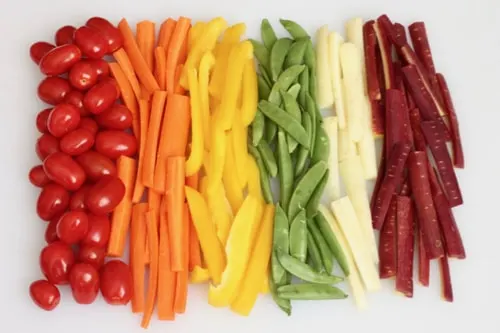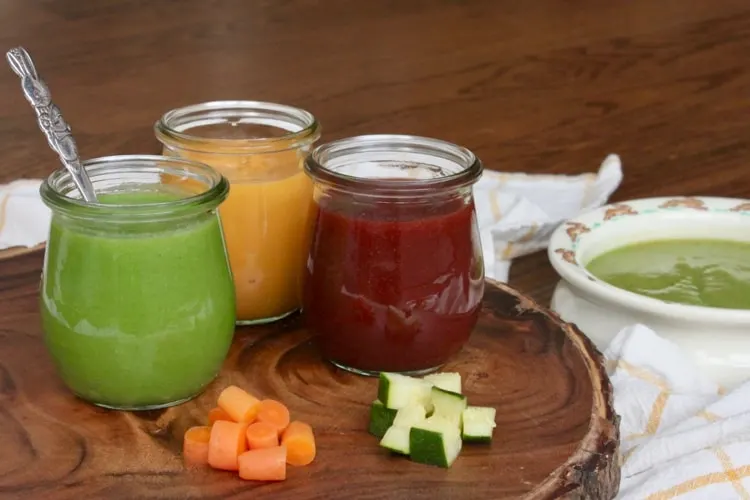Have you ever wondered how can you get your children to eat more vegetables? Or perhaps increase the variety of vegetables they eat? These simple research-based tips are proven to encourage infants and toddlers to eat more veggies.
A recently published article summarized 48 separate research studies investigating how to encourage young children to eat more vegetables.(1)
Some of the successful methods may be familiar to you, however there are probably a few that you did not know.
How to teach young children to eat their veggies
An early introduction to vegetables has been shown to have long-lasting effects on both liking and intake of veggies.
Children who eat a varied diet full of vegetables and fruits tend to continue to do so as adults.
For this reason, the research summary focused on studies conducted with young children between the ages of 6 months to 3 years.

Proven ways to encourage your child to eat their vegetables
Research has shown that the following strategies can successfully encourage infants and toddlers to eat more vegetables.
1. If at first you don’t succeed, try, try again
Frequently offering a new veggie to a young child is a highly successful way to increase a child’s acceptance and overall intake of the new vegetable. This strategy, referred to as “familiarization through exposure,” results in a long-term increase in the total amount of veggies that young children eat. However, this “frequent exposure” strategy can take between 8 to 10 separate tasting opportunities to work.
This method also works on veggies that your children do not like. Several studies have shown that repeatedly offering a previously rejected veggie to infants and toddlers is an effective way for the child to learn to like the vegetable.
Recommendation: Persistence pays off when introducing veggies to young children. However, to save yourself (and your child) some frustration. This strategy will work best when your child is not exhausted and when you are at your most patient.

2. Veggie variety increases all vegetable intake
Research has shown that the schedule used to introduce new vegetables to infants and toddlers is also important. Offering young children a variety of vegetables increases their overall liking and consumption of all veggies.
Does this mean you should offer three different veggies at each meal? Not necessarily. One study demonstrated that both within-meal and between-meal variety increased 6-month olds acceptance of a new vegetable.(2)
Recommendation: Mix it up! Try to offer three veggies to your infant or toddler either at a single meal or over the course of one day.
3. Set a good example! Let your child see you eating your veggies
Infants are natural imitators, and parental behaviors are highly influential. If you want your child to eat their vegetables, they need to see you eating your veggies.
Research has shown that children will eat more of a new food when they see a parent eating the new food.(1)
In fact, a mothers’ consumption of fruit and vegetables has been shown to be the strongest predictor of children’s fruit and vegetable consumption.(3)
Recommendations: Model the healthy eating behaviors you want your child to adopt. And whenever possible, eat meals with your child.
What NOT to do when introducing veggies
One common strategy for encouraging young children to eat a new vegetable is to combine it with a sweet food (fruit) or ingredient (sweetener).
While this method of introducing a veggie can be successful, research has shown that it does not work better than simply offering the vegetable frequently.
Recommendation: When introducing young children to veggies, the ultimate goal is for them to develop a taste for vegetables.
Masking the flavor of a vegetable with a sweet taste may prevent them from learning to like bitter flavors.
Help your child develop healthy eating habits from the very beginning and try to not rely on added sweeteners to encourage your child to eat their vegetables.
Final thoughts on raising veggie lovers
When infants are born, they like sweet flavors and often reject bitter tastes.(4)
Children must therefore learn to like bitter tasting foods, like vegetables.
Research has shown that repeatedly offering a variety of vegetables is the best way to have infants and toddlers eat (and like) their veggies.
These strategies work on a variety of vegetables, not simply peas and carrots!
Using these techniques, researchers have taught young children to enjoy eating a wide variety of veggies including artichoke, endive, and even salsify.
More tips for eating healthier…
Are you part of the 90% of adults who doesn’t eat enough vegetables?(5). Check-out our Five Simple Research-based Tips to Eat More Veggies.
Pin article for later:
References
- How Infants and Young Children Learn About Food: A Systematic Review. Frontiers Psychol., 8: 1046 (2017) (link)
- Variety is the spice of life: strategies for promoting fruit and vegetable acceptance during infancy. Physiol. Behav. 94, 29-38 (2008) (link)
- Influence of mother’s educational level on food parenting practices and food habits of young children. Appetite 43, 93-103 (2004) (link)
- Human facial expressions in response to taste and smell stimulation. Adv. Child Dev. Behav. 13, 257-295 (1979) (link)
- Dietary Guidelines for Americans, 2015-2020, Eighth Ed. (link)


Sarah @ The Fit Niche
Tuesday 1st of May 2018
Great post! Loved the tip, thanks for sharing :)
Meredith
Tuesday 1st of May 2018
Thanks so much Sarah!